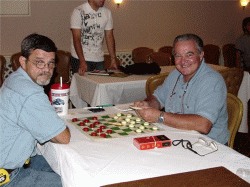The Checker Maven
The World's Most Widely Read Checkers and Draughts Publication
Bob Newell, Editor-in-Chief
Published every Saturday morning in Honolulu, Hawai`i
Noticing missing images? An explanation is here.
Allan Millhone Plays Checkers
To accompany our interview with American Checker Federation President Alan Millhone, we present these two fine games played by Mr. Millhone in the 2006 District 6 Checker Tournament, against no less an opponent than World Champion Alex Moiseyev. The games have been expertly annotated by Dr. Richard Beckwith.


Games from 2006 District 6 Tournament
Game 1
Black: Alan Millhone
White: Alex Moiseyev
10-14 22-18 11-16 26-22---A 8-11---B 22-17---C 16-20---D 17x10 6x22 25x18 9-14---E 18x9 5x14 29-25 7-10 25-22 3-7 30-26 11-15 24-19 15x24 28x19 4-8 22-17 7-11 17-13 11-16 26-22 8-11 22-18---F 1-5 18x9 5x14 13-9 11-15 9-5 15x24 23-19 16x23 27x9 12-16?---G 5-1 10-14 1-6 14-18 6-10 18-22---H 10-15 22-25---I White Wins.
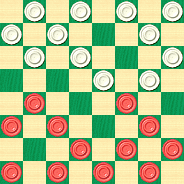
BLACK
Black to play (note D)
B:W32,31,30,29,28,27,25,24,23,21,18,17:B16,14,12,11,9,7,6,5,4,3,2,1.
WHITE
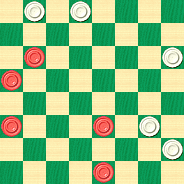
BLACK
Black to Play and Draw (note G)
B:W32,31,21,9,5:B24,20,12,10,2.
A---Also reached from 11-16 23-18 10-14 26-23 same.
B---Natural, but a very weak reply, unless one has a prepared defense. In fact, Solid Checkers gives 8-11 a question mark. The two usual alternatives are 7-10 and 16-20. The 16-20 move permits 22-17 7-10 and the option of a good off-Bristol-Cross variation with 17-13 now, as shown in Basic Checkers Op. # 120 trunk, the line where 24-19 is held back. To keep more options open, 7-10 has been suggested (instead of 16-20 or 8-11), then 22-17 and now black has the option of 16-20 (into the same line just mentioned) or the 16-19 bust.
C---A good move by the world champ, whereas 24-19 allows 16-20 and back into a standard Bristol-Cross.
D---See diagram prior to 16-20. Alan has previously played the published 7-10 here (vs. L. Cowie in 2005 OH Ty.), but I like this 16-20 better! Both BC and SC give only 7-10 25-22 3-7 31-26 9-13 18-9 5-14 23-19 with white powerful.
E---While this will get through to draw, black also has 7-10 as a defense (perhaps new?). Continue with 24-19 (or 29-25 3-7 24-19 11-15) 11-16 and into an old secondary Bristol-Cross defense often used by another Ohio player, Louis Cowie (and occasionally by your annotator as well). This position normally arises from 11-16 23-18 16-20 24-19 10-14 26-23 8-11 22-17 11-16 17x10 6x22 25x18 7-10.
F---13-9 (liked by programs, but not necessarily better) 11-15 32-28 15x24 28x19 1-5 31-26 2-7 22-18 14-17 21x14 10x17 9-6 17-21 6-2 7-10 2-6 10-14 18x9 5x14 26-22 21-25 6-2 (or 6-10 14-18 22x15 25-30 draw) 25-30 2-6 and now pitching the man on 14 is necessary, and then the king can attack the elbow to draw. rcb
G---Sets up a “breeches” problem later. Instead, 10-15 5-1 15-18 31-26 12-16 (now OK with 31-26 played) 1-5 2-7 9-6 16-19 5-9 7-11 (whoops! 18-23 draws this game) 32-27 & 9-14 WW, T. Laverty – R. Jones 1987 Florida Open
H---Now black cannot advance to 23 to set up a trade due to the king advance with 10-15 & 15-19.
I---The scoresheet ended here, but the position will win for white given the three stranded black pieces in front of the double corner, as well as additional white kings “on the way.”
Game 2
Black: Alex Moiseyev
White: Alan Millhone
10-14 22-18 11-16 25-22 16-20 29-25---A 8-11---B 18-15---C 11x18 22x15 4-8---D 26-22---E 7-10 31-26 10x19 24x15 6-10---F 15x6 1x10 22-18---G 8-11 28-24 10-15 25-22 2-7 23-19 14x23 19x10 7x14 26x19 9-13 22-18 14x23 27x18 20x27 32x23 11-16 18-15 16-20 15-11 20-24 23-18 24-27 18-15 27-31 11-7 3x10 15x6 31-27 6-2 5-9 2-6 9-14 19-15 14-18 6-9 18-22 15-10 27-23 21-17 Drawn.
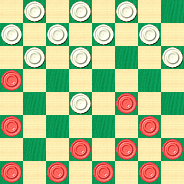
BLACK
Black to Play (note D)
B:W32,31,30,28,27,26,25,24,23,21,15:B20,14,12,9,7,6,5,4,3,2,1.
WHITE

BLACK
Black to play (note F)
B:W32,30,28,27,26,25,23,22,21,15:B20,14,12,9,8,6,5,3,2,1.
A---A natural development, but 24-19 is preferred, or taking the Bristol-Cross a move earlier, as Alex did in Game 1. Historically, 29-25 has thrown the advantage back to black.
B---This position is also reached by either 11-16 22-18 16-20 25-22 8-11 29-25 10-14 or by 12-16 22-18 16-20 25-22 8-12 29-25 10-14.
C---24-19 is known to be “bad” by well-versed players due to the bind, but narrow draws do exist. Continue: 11-16 (4-8 19-15 7-10 27-24 draws) 18-15 4-8 28-24 7-10 15-11* (instead of 22-18 and Ryan’s “Pickle Barrel trap” given in Solid Checkers) 8x15 23-18 14x23 27x11 16x23 26x19 20x27 31x24 10-15 draws, Wyllie-Barker, 1882, from 11-16 24-19 8-11 opening.
D---See diagram prior to 4-8. There are three established options here, with 7-10 (Var. 1) being best for black, and a review of the OCA database reveals the majority of these games have resulted in black wins. The 4-8 played here has historically favored white. The third option is 9-13 (Var. 2), as given in Basic Checkers Opening #116 trunk.
E---Well played by Alan, leaving black to use care to draw. 24-19 instead is wanted, then 7-10 leads to the “bad stuff” for white in Var. 1.
F---See diagram prior to 6-10. Not 14-18? 23x14 9x18 21-17* (instead of 26-23 3-7 23-14 6-10 draw, Gonotsky-Lieber, 1928) 2-7 26-23 6-9 23x14 9x18 30-26 1-6 26-23 12-16 23x14 7-10 14x7 3x19 25-21* 5-9 22-18 9-13 17-14 13-17 18-15 17-22 21-17 22-26 17-13 8-12 27-24 20x27 32x23 26-31 23-18 31-26 14-9 26-23 9x2 23x14 15-10 WW, J. Hanson.
G---Leads to a quiet draw, likely unpublished. (And any quiet draw for an “average” player against a world champ is a good one!) The usual press is with 23-18 14x23 27x18 9-13 18-14 10x17 21x14 2-6 22-18 6-10 14x7 3x10 26-23 8-11 23-19 20-24* 19-16 11x20 28x19 to a draw, Rubin-Hunt 1934 Am. Ty., from 12-16 22-18 16-19 opening.
Var. 1 7-10 24-19---1A 4-8 27-24---1B 20x27 31x24 9-13 (2-7 also strong) 24-20 3-7 25-22 5-9 30-25!---1C 1-5 22-18 14-17 21x14 10x17 19-16 12x19 23x16 17-21 16-12 21x30 12x3 30x14 3x1 to a strong black ending, but probable draw. RCB.
1A---Very weak, now that the draws of note C have been bypassed. White should play the 25-22 10-19 23-16 pp draw.
1B---Basic Checkers also mentions 26-22 and 23-18, but both are given to lose. The 27-24 is the best bet to draw, although the line should be avoided altogether.
1C---Instead of 22-18 or 32-27 in BC, Op 116 note F1.
Var. 2 9-13 26-22---2A 5-9---2B 22-18---2C 7-10 30-26*---2D 10x19 24x15 3-7 25-22 7-10 15-11 12-16---2E 22-17 13x22 26x17 16-19 23x16 14x23 27x18 10-14 17x10 6x22 11-7 Drawn. RCB.
2A---Or 24-19 4-8 28-24 as in BC, Op #116 trunk.
2B---Or 13-17 & 6-9 draws, which may be best if the upcoming 30-26 improvement is feared.
2C---31-26? 7-10 22-18 10x19 24x15 3-7 25-22 (starred in BC, but appears to lose given upcoming correction) 7-10 23-19 14x23 27x18 10-14 26-23 20-24 15-10 6x15 18x11 24-27 19-15 13-17* (correcting 1-5 to draw in BC) 22x6 1x26 30x23 12-16 28-24 27-31 24-19 16-20 19-16 31-27 BW. RCB.
2D---Avoiding 31-26 and back into the previous note. White is now better after 30-26.
2E---10-15 28-24 12-16 24-19 15x24 18-15 16-19* 23x16 14-18 15-10 18x25 32-28 6x15 28x10 25-30 26-23 2-6* 10-7 6-10 7-2 10-14 2-7 1-5 16-12 30-26 31x22 14-17 21x14 9x25 Drawn. RCB.
And now, as a special bonus for those of our readers who have come this far, we present a game in which we know Mr. Millhone takes great pride; a game in which he made a draw against the greatest checker player of all time, Dr. Marion Tinsley.


Black: Marion Tinsley
White: Alan Millhone
11-15 23-18 8-11 26-23 10-14 30-26 6-10 24-19 15x24 27x20 2-6 28-24 10-15 32-28 7-10 22-17 15x22 25x18 10-15 17x10 15x22 26x17 6x15 29-25 9-13 17-14 15-18 24-19 18x27 31x24 3-7 25-22 1-6 19-16 12x19 24x8 4x11 22-18 13-17 28-24 6-10 24-19 17-22 21-17 22-26 17-13 10x17 19-15---A Drawn.
A---The only move to draw, and a fitting conclusion to a game played without even the smallest of errors.
Mr. Millhone modestly calls himself "an average player" but these games show that if this is "average" play, wouldn't we all like to be "average" ourselves!![]()
A Sports Bar Debate
There was a big Sunday afternoon crowd at the Mojo Sports Bar in downtown Detroit. Glasses and bottles were everywhere to be seen as the crowd buzzed over a just-completed exhibition match, narrowly and unexpectedly lost by the hometown Major League team, the Detroit Doublejumpers, to the Bridgeport Breeches of the AAA Northeastern League. The match, of course, was viewed on the bar's large-screen TV, and broadcast by the Checker Television Network.
In the final round, Detroit captain Marvin J. Mavin had lost his first-board game to Bosco della Bruggia of the Breeches, costing the Doublejumpers the match. The network commentators thought the game wasn't all that well played; and they felt Marvin had missed a last-ditch draw. Some of the bar patrons agreed with this assessment, but they were in turn opposed by a number of the other patrons, who, as fierce hometown supporters, backed Marvin avidly.
A large group was gathered around a table where a pair of fans were going over the game. One of the onlookers, Johnny Jack Jackson by name, had played some semipro checkers a few years back, and was generally held to be the bar's champion (he would play for a beer and rarely went home sober). Johnny was commenting on the game as the moves were run up.

Johnny Jack Jackson Does the Play-By-Play
11-15 23-18
8-11 18-14
"Most of 'em plays 27-23 or some of 'em plays 26-23. 18-14 is a little different but it's OK. I seen it before from that guy Ed Queensline who plays AA checkers for Morristown out in Jersey."
9-18 24-19
15-24 22-8
4-11 27-20
"Aw c'mon Marvin, you oughtta capture toward the center with 28-19."
10-15
"I wouldda played 5-9 but this ain't so much worse."
... 28-24
"25-22 or maybe 21-17 .... you're givin' Bosco the edge here, Marv!"
6-10
"Now, I'd a played 5-9 right away. I 'spose Bosco was goin' for that element of surprise bit."
... 26-23
"Marvin, you give 'em a little on each move! You still couldda played 25-22. You probably got a loss now, pal."
5-9 21-17
9-14 25-21
15-18 ...
"Marv, I'd say you got a real big problem.... like, you lose!"
... 32-27
18-22 30-26
"Some a you guys wouldda played 30-25 instead, but after 1-6 it ain't so great. It's a two for two and Black gets an even easier win."
1-6
"What a stinko move, Bosco! 11-15 wouldda nailed down the game but now Marvin's right back in there."
17-13
14-17 21-14
10-17 23-18
7-10
"We're headed straight for a draw now."
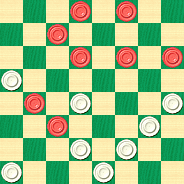
WHITE
White to Play and Draw
... 18-14
"Marvin, you're a dumb bum! You blew it---- again!"
11-15
"Well, OK there Bosco, you still win just fine, but I kindda like this line: 12-16 14-7 3-10 26-23 10-15 23-18 6-9 13-6 2-9 27-23 17-21 game over."
... 14-7
3-10 27-23
10-14 23-19
6-10 13-9
14-18 9-5
18-23 5-1
23-20 Black Wins.
"So our boy Marvin runs into an early loss but then Bosco plays a bonehead move and puts Marv back in the game. Does he get his draw? Noooo! He's gotta blow it away a second time with that 18-14 move! Ahhh.... it wasn't such a great game anyhow. Exhibitions, they just goof around sometimes instead a playin' serious."
Loud discussion ensued, with some thinking that 18-14 was indeed the best move and others not so sure. But Johnny insisted, and pretty soon little groups around the bar were playing out the variants and wagering a few tall cool ones on the results.
What do you think? Could Marvin have saved the draw? Would you be willing to bet Johnny a beer (or two) on your answer?
Click on Read More when you've decided.![]()
A Leak in the Dyke

In 1931, the great checkerist Louis C. Ginsberg wrote what may be his only book on checkers, a little booklet called Principles of Strategy in the Game of Checkers. It was later reprinted by William Ryan, with the addition of an informative and highly entertaining introduction.
Principles of Strategy appears to have been the prototype for other similar booklets which never got written, although we can't be quite sure about this. Principles of Strategy, while mentioning the existence of numerous other characteristic formations in the game of checkers, deals exclusively with what are known as "Dyke" formations.
The booklet is a real gem and a welcome addition to the library of any checkerist; it is especially useful at the early intermediate stage of development. In conjunction with Bob Murr's PDN file of the examples contained in this work (see link in the column to the right), today we'll present the full text of two of these examples. Pay close attention to the Example 15 below, as it will help you solve the problem we pose later.
"DYKE" FORMATIONS---EXAMPLE 15
9-13 24-20
11-15 22-17
13-22 25-11
8-15 21-17
4-8 29-25
15-19-A 23-16
12-19 27-23
8-12 23-16
12-19 17-13-B
10-15-C 20-16
6-1-D Drawn
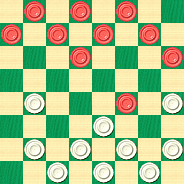
WHITE
Position at Note A, White to Move
A---This illustration is given to show when Black can place a piece on 19 with apparently only two pieces in reserve for the defense of the man. There must be a White man on 17.
B---White must remove the man from 17 before going 32-27 to attack the man on 19.
C---Black gains a move, an idea that is utilized in many different games, due to the White man being located on 17. If there was no White man on 17, the man on 19 would be lost to Black by the runoff via 27-23.
Get the idea? Now let's look at a Dyke example that arises in the Single Corner opening:
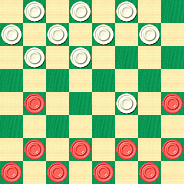
BLACK
Dyke Position with Black to Play
11-15 22-18
15-22 25-18
12-16 29-25
9-13 18-14
10-17 21-14 (diagram above)
16-20 24-19
6-10 25-21
10-17 21-14
2-6 30-25
6-10 25-21
10-17 21-14
1-6 Black Wins.
The White "Dyke" man on 14 is lost as there is no defense against Black's next move, 6-10.
What went wrong here? We've left it to you to find the leak in this Dyke. Can you find White's losing move and correct it? Click on Read More when you have your answer.![]()
Did Marvin Blow the Game? (Conclusion)


Marvin J. Mavin and Jean Luc Tournevise
1. 11-15 22-18
2. 15x22 25x18
3. 12-16 29-25
4. 10-14 24-19
5. 16-20 25-22
6. 7-10 28-24
7. 8-12 32-28
8. 4-8 30-25
9. 3-7 18-15
10. 9-13 19-16
11. 12x19 23x16
12. 10x19 24x15
13. 8-12 15-11
14. 12x19 11-8
15. 7-10 8-3
16. 2-7
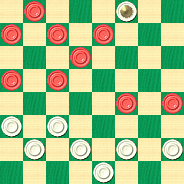
WHITE (Louie)
White to Play - Can White Win?
16. ... 27-24
17. 20x27 31x15
18. 10x19 3x17
"You sill-ee boy, did you not see zees ... how you say eet ... shot?'" he gloated after this move. "Maintenant, vous etes foutu!"
But the game continued this way:
19. 5-9 17-14
20. 9x18 22x15
21. 6-10 15x6
22. 1x10 25-22
23. 10-14 28-24
24. 19x28 26-23
25. 28-32 22-18
26. 32-27 18x9
27. 27x18 Red Wins!
"First Position, mon cher ami," said Marvin in a matter-of-fact manner. "Uh, in plain old American, you might just say, 'You lose, pal!'"
Louie treated Marvin to his best scowling glare. "I sim-plee cannot un-derstand eet!" he exclaimed. "Zis ligne - it is a no good way to play at Dames. Why I lose eet to zis clune americaine?"
"Ah, Frenchy," responded Marvin in a most politically incorrect manner, "you just gotta learn a little more checkers if you wanna beat Marvin. Ya wanted a draw, ya hadda play like this."
Marvin quickly reset the pieces to the original diagrammed position and played out these moves:
16. ... 3-8
17. 14-17 21x14
18. 10x17 27-24
19. 20x27 31x15
20. 17-21 8-12
21. 21x30 28-24
22. 30x23 15-11
23. 7x16 12x26 Drawn (White has a man-down draw).
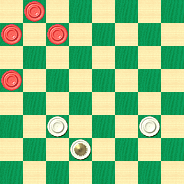
White
Red to Play, White to Draw
(Can you figure out the draw that Marvin and Louie think is so clear? Try it, then click on Read More below to see the solution.)
"Ya see, ya just hadda move your King away, and ya coulda got a nice man-down draw. But ya got a little too greedy fer yer own good," Marvin pontificated.
"Un moment, s'il vous plait," Louie cut in. "Per'aps I play eet 26-22 at move 22 and I will not 'ave zees First Postion of yours?"
"Nah, Louie, that ain't right neither. Lookit...." Marvin replied. He set the pieces back to the original diagrammed position one more time and showed the following play.
16. ... 27-24
17. 20x27 31x15
18. 10x19 3x17
19. 5-9 17-14
20. 9x18 22x15
21. 6-10 15x6
22. 1x10 26-22
23. 10-14 22-18
24. 14x23 25-22
25. 23-27 22-18
26. 27-31 18-14
27. 31-27 14-9
28. 27-23 9-6
29. 19-24 28x19
30. 23x16 6-2
31. 16-11 2-6
32. 11-15 6-9
33. 15-18 Red Wins.
"Zut!" cried Louie. "Encore une fois ... it ees zee First Position! Monsieur Marvin, you make zee connerie on Jean Claude Louis!"
"Louie," Marvin replied, "Face it. Ya just wasn't good enough to outsmart ole Marvin J. Mavin. Now c'mon, let's go across the street and I'll buy ya une biere in the name of amitie internationale!"

Well, whether you yourself solved this one or not, you've also surely earned yourself une biere for trying. We hope you enjoyed looking into this fascinating and instructive position. There is much more to it than we have space to present here, so grab that beer, and use your computer to explore the variant lines.
And, we're pleased to say, our hero Marvin did not blow the game!
French-English Glossary:
maintenant vous etes foutu now you are finished
mon cher ami my dear friend
ligne line, as in "line of play"
Dames French name for checkers, though more often referring to international rules
clune americaine American clown
un moment s'il vous plait one moment if you please
zut drat
connerie best translated here as "trickery"
encore une fois once again
une biere a beer
amitie internationale international friendship
(Accent marks have been omitted throughout. --Ed.)
[Read More]The 2005 ACF 9th District Tournament
The first three days of August saw unusual action in the gaming rooms of the Four Queens in Las Vegas, Nevada.

No, we're not talking about Blackjack or Texas Hold'Em, though we're sure there was plenty of action of that type elsewhere in the casino.
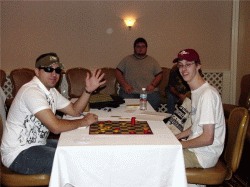
Nery Cardenas and Ryan Pronk; Tom Jones and John Cardie
We're talking about the 2005 edition of the American Checker Federation 9th District Tournament, organized by California checker stalwart Gerry Lopez. A small but enthusiastic group of players gathered in the City of Entertainment for some serious cross-board action.
Competition took place in two divisions, with these final results:
A Division
| Ranking | Name | State | Points | Remarks |
|---|---|---|---|---|
| 1. | Gerry Lopez | CA | 10 | 2005 Cal. and Dist. 9 Champion |
| 2. | Nery Cardenas | CA | 8 | |
| 3. | Ryan Pronk | AZ | 4 | withdrew |
| 4. | Bob Murr | CO | 2 |
B Division
| Ranking | Name | State | Points | Remarks |
|---|---|---|---|---|
| 1. | John Gibson | CA | 20 | |
| 2. | Alex Lopez | CA | 18 | first tourney |
| 3. | John Cardie | CO | 16 | first tourney |
| 4. | Robert Ferguson | UT | 14 | first tourney |
| 5. | Tom Jones | NV | 8 | first tourney |
| 6. | Paul Stein | CA | 4 | |
| 7. | Joe Coleman | IA | 2 |
Division A Game 1
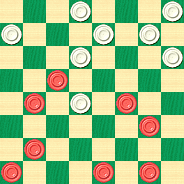
Red
Position at Note B, Red to Play and Draw
| [Event "9th District 2005 Round 2 Game 1"] | |
| [Date "2005-08-01"] | |
| [Red "Ryan Pronk"] | |
| [White "Bob Murr"] | |
| [Result "0-1"] | |
| 1. 11-16 23-18 | 2. 7-11 26-23 |
| 3. 3-7 30-26 | 4. 16-19 (A) 23x16 |
| 5. 12x19 24x15 | 6. 10x19 27-24 |
| 7. 7-10 24x15 | 8. 10x19 32-27 |
| 9. 9-14 18x9 | 10. 5x14 27-23 |
| 11. 11-16 22-18 | 12. 6-9 18-15 |
| 13. 8-12 (B) 25-22 | 14. 16-20 23x16 |
| 15. 12x19 15-11 | 16. 20-24 22-17 |
| 17. 14-18 26-22 | 18. 18x25 29x22 |
| 19. 19-23 28x19 | 20. 9-13 17-14 |
| 21. 23-26 (D) 19-15 (E) | 22. 26-30 22-18 |
| 23. 30-25 14-10 | 24. 25-22 10-7 |
| 25. 4-8 11x4 | 26. 2x11 15x8 |
| 27. 22x15 8-3 (F) | 28. 15-11 31-26 |
| 29. 1-6 26-22 | 30. 11-15 4-8 |
| 31. 15-10 8-11 | 32. 10-14 3-7 |
White wins.
(A) 9-14 would be an alternative here but there is nothing wrong with the actual move.
(B) The losing move. 1-5 should have held the game.
(C) King's Row prefers 1-6 here, but the game is still lost for Red.
(D) Again, KR prefers 1-5 here ...
(E) ... and 22-18 here, but the outcome won't change.
(F) There is little left to say, or play.
Annotations from King's Row.
Division A Game 2
Notes by Ryan Pronk
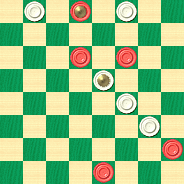
Red
Position at Note G, Red to Play and Draw
| [Event "9th District 2005 Round 1 Game 1"] | |
| [Date "2005-08-01"] | |
| [Red "Ryan Pronk"] | |
| [White "Nery Cardenas"] | |
| [Result "1/2-1/2"] | |
| 1. 11-16 21-17 | 2. 9-14 (A) 17-13 (B) |
| 3. 16-19 (C) 23x16 | 4. 12x19 24x15 |
| 5. 10x19 25-21 | 6. 8-11 27-23 |
| 7. 6-10 23x16 | 8. 11x20 26-23 (D) |
| 9. 14-17 (E) 21x14 | 10. 10x26 31x22 |
| 11. 4-8 22-18 | 12. 8-11 29-25 |
| 13. 7-10 25-22 | 14. 10-14 18x9 |
| 15. 5x14 22-18 | 16. 14-17 23-19 |
| 17. 17-22 13-9! | 18. 1-5 (F) 18-14 |
| 19. 20-24 19-16 | 20. 11x20 28x19 |
| 21. 20-24 19-16 | 22. 3-7 16-12 |
| 23. 7-11 12-8 | 24. 11-15 8-3 |
| 25. 15-18 3-8 | 26. 18-23 8-11 |
| 27. 24-27 11-15 | 28. 27-31 15-18 (G) |
| 29. 22-26 18x27 | 30. 31x24 30x23 |
| 31. 24-27 23-18 | 32. 27-23 18-15 |
| 33. 23-18 15-11 | 34. 18-22 |
Drawn.
(A) A 3-move opening that usually transposes into
Pioneer lines.
(B) Regarded as inferior because it allows the
powerful 16-19 dyke. Going into Pioneer lines with
25-21 is best. However, if the opening were 12-16,
21-17, 9-14, then this 17-13 (as preferred by Tinsley)
would be best.
(C) Planting the piece on 19, and making for a strong
game - but not in this case!
(D) Really took me by surprise. I was expecting 22-17
which may give white a stronger game. But as they
say, the element of surprise is sometimes good enough
to win!
(E) Is there anything better than this natural move?
(F) Again the previous move really took me by
surprise, but after this 1-5, I could see to the end
of the game.
(G) A nice problem setting for the beginner.
Division B Game 1
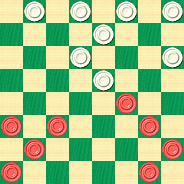
Red
Position at Note E, Red to Play and Draw
| [Event "9th District 2005 Round 6 Game 1"] | |
| [Date "2005-08-02"] | |
| [Red "Robert Ferguson"] | |
| [White "John Cardie"] | |
| [Result "0-1"] | |
| 1. 10-14 22-18 | 2. 11-15 18x11 |
| 3. 8x15 24-19 | 4. 15x24 28x19 |
| 5. 7-11 25-22 (A) | 6. 3-8 (B) 22-18 (C) |
| 7. 6-10 19-15 | 8. 10x19 23x7 |
| 9. 2x11 27-23 (D) | 10. 1-6 (E) 29-25 (F) |
| 11. 6-10 (G) 25-22 | 12. 12-16 22-17 |
| 13. 9-13 18x9 | 14. 5x14 23-18 |
| 15. 13x22 18x9 | 16. 22-25 9-6 |
| 17. 25-29 21-17 | 18. 8-12 6-2 |
| 19. 10-15 17-14 | 20. 15-19 2-6 |
| 21. 4-8 14-10 | 22. 19-23 26x19 |
| 23. 16x23 10-7 | 24. 12-16 7-3 |
| 25. 8-12 3-8 | 26. 11-15 8-11 |
White Wins.
(A) 23-18 would be better here.
(B) 4-8 is stronger; KR thinks 3-8 is quite weak.
(C) 29-25 is better but White already has a strong game.
(D) This moves blows away the win! 29-25 would have won easily.
(E) But Red misses the chance! 14-17 would have drawn.
(F) White gives Red another shot at a draw! 26-22 would have won here.
(G) And for the last time, Red misses the chance to draw with 14-17. Beyond this point there are some sub-optimal moves on both sides, but Red is lost no matter.
Annotations from King's Row.
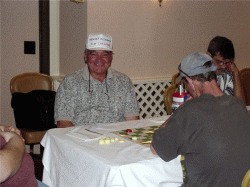
John Cardie, Winning!
The Checker Maven congratulates Gerry Lopez for not only having organized this event, but taking home the District 9 and California championships!

Champion Gerry Lopez
Our thanks to Bob Murr for photos and games, Ryan Pronk for additional games, and Gerry Lopez for permission to publish.
A Great Shot, But Can You Win The Ending?

Pexels CC0
(We are taking a short break and so this really is our last Wednesday column until September. Saturday columns will of course continue without interruption.)
On this "Anything Can Happen" Wednesday, we bring you a game played by guest author Ingo Zachos in a recent matchup on the It's Your Turn on-line game site. Capitalizing on an error by his opponent, Ingo finds a thrilling shot--- and then still has to demonstrate the win in the endgame! We've interspersed Ingo's own interesting comments and analysis with our own, which are due to running the world-class King's Row program at 15 minutes per move.
Ingo Zachos - Raymond Faircloth
It's Your Turn January 2005
with commentary by Ingo Zachos
1.11-15 23-18
2.8-11 27-23
3.4-8 23-19
4.10-14 19x10
5.14x23 26x19
6.6x15
I know 6.7x14 is the fashion, but I was inspired by Game 7 of the GAYP World Championship of 1956, Wiswell- Fraser, after reading International Checkers and Draughts.
6...19x10
7.7x14 24-19
8.11-16 31-26
Here Fraser played 8...19-15 and after 9.16-19 22-17 10.14-18 25-22 11.18x25 29x22 12.12-16 22-18 13.16-20 17-14 14.9-13 14-10 15.19-23 18-14 16.2-7 31-26 17.7-11 26x19 18.11x18 he played 19-16 and lost, thus: (18...32-27 19.18-22 19-16 20.8-12 16-11 21.12-16 28-24 22.22-25 21-17 23.13x22 30x21 24.22-26 21-17 25.26-31 10-7 26.3x10 14x7 27.1-6 7-3 28.6-10 3-7 29.10-15 7-10 30.16-19 27-23 31.19x26 10x19 32.20x27 19-23 is given by Dr. Fraser as drawn.) 19.18-23 16-12 20.8-11 10-7 21.3x17 21x14 22.1-6 12-8 23.13-17 8-3 24.17-21 3-8 25.23-27 8x15 26.6-9 32x23 27.9x27 28-24 28.27-31 24-19 29.20-24 15-18 30.24-28 19-16 31.28-32 18-22 32.32-27 16-12 33.5-9 22-17 34.27-23 12-8 35.23-19 8-3 36.19-15 3-7 37.31-27 7-2 38.15-10 17-22 39.27-23
9.16x23 26x19
10.8-11!?
10.9-13 trying to avoid the rapid advance of White's single corner side, is better, but I underestimated the power of the man on 15. (King's Row thinks any of 2-6, 1-6, 2-7, 8-11, 9-13, or 3-7 are about equal. --Ed.)
10...19-15
11.11x18 22x15
12.12-16
I also calculated 12.2-7 28-24! but there seemed to be equality with less chances of a tactical surprise. (The idea was the trick 12...15-10? 13.14-17 21x14 14.9x18 to a neat win.) 12.3-8?! would be a minor variation because of 15-10 and the piece on 10 is very disturbing. (In fact, Kings's Row agrees that 3-8 is weak. --Ed.)
12...15-11?!
13.14-17!?
Sometimes masters say they calculate 50 moves ahead. Well, here I already saw the final position of this game in my mind very clearly and knew it was won.
13.1-6 as indicated by the programs, might be better, but during the game I evaluated it as drawn.
(Editor's note: King's Row thinks 12. ... 15-11 is inferior, though not an outright loss, and prefers 30-26 or 25-22. But King's Row disagrees with our author over 13.14-17, rating the resulting position as a draw. As our author points out 1-6 is preferred but the game is still far from a win.)
13...21x14
14.9x18 30-26?
Believe it or not, this is already the fatal mistake.
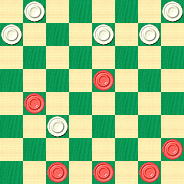
RED
Red to Play and Win
(Editor's note: let's pause here. Ingo is about to play an exciting shot. Can you spot it? And if you can, are you able to demonstrate the win after the shot is complete? When you've figured it out, click on Read More to see the rest of the game.)
[Read More]Did Marvin Blow The Game?

The Detroit Doublejumpers, lead by their intrepid team captain, Marvin J. Mavin, were at the St. Louis Sports Drome for a contest with the St. Louis Switchers. Marvin was engaged in a First Board match with the Switchers captain, that intrepid French National named Jean Luc Louis Claude Simon Tournevise, otherwise known as "Louie Screwdriver."
"You 'ave made a vehree bad ligne of play," remarked Louie with a curling of the lip and a bit of a sneer. "Maintenant, I will 'ave to show you zee ehror of zis ligne by giving you zee beating!"
Here is how the game had played out so far. Marvin, who was commanding the Red pieces, and Louie, in charge of the White forces, had indulged themselves in this line of the Single Corner:
| 1. | 11-15 | 22-18 |
| 2. | 15x22 | 25x18 |
| 3. | 12-16 | 29-25 |
| 4. | 10-14 | 24-19 |
| 5. | 16-20 | 25-22 |
| 6. | 7-10 | 28-24 |
| 7. | 8-12 | 32-28 |
| 8. | 4-8 | 30-25 |
| 9. | 3-7 | 18-15 |
| 10. | 9-13 | 19-16 |
| 11. | 12x19 | 23x16 |
| 12. | 10x19 | 24x15 |
| 13. | 8-12 | 15-11 |
| 14. | 12x19 | 11-8 |
| 15. | 7-10 | 8-3 |
| 16. | 2-7 | ... |
This resulted in the following position, with White to play:

WHITE (Louie)
White to Play - Can White Win?
Marvin seemed only slight irritated by Louie's taunts. He simply replied, in his most politically incorrect manner, "Well there, Monsieur Frenchy, you ain't a gonna pull this one off nohow!" Louie looked puzzled. "Ah, I do not un-derstand zis American way of fun-ee talk-ing," he replied, "but I un-derstand 'ow to make of zis game a vic-toree!"
What do you think? Try your luck and skill on these questions:
1. Can White (Louie) find a win in this position? What might it be?
2. Does Red have something up his sleeve, or did Marvin perhaps have a little too much pre-game beer?
3. What do you think of this line of the Single Corner? Did Red play well? Did White?
Watch The Checker Maven for the conclusion of this story, and the answers to all these questions and much more, in a few weeks' time.
French-English Glossary
ligne line, as in "line of play."
maintenant now, as in "now I'll show you!"
tournevis screwdriver.
Note: In this article, we're trying out a different diagram style and using the term "Red" instead of "Black" --- all in response to reader feedback. Let us know what you think.![]()
The Fun Shot in the Single Corner Opening: Conclusion
(Please see our previous article for the first part of this story.)
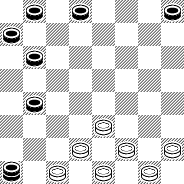
WHITE
White to Move - and Win?
26-22.
Was that a smug look on Marvin's face? Could our hero possibly be thinking, well, less than charitable thoughts about getting even after being heckled by Billie and some of the others? Would Marvin J. Mavin do such a thing?
Marvin smiled, and said, rather loudly, "Hmmph. Well, son, that was a logical move, but unfortunately, it won't get you a win!"
Billie seemed taken a bit aback. He thought for a moment, remembering his teacher's instructions to be "on your best behavior," and then replied with a snicker, "Wanna bet, beer belly?" There was a ripple of laughter from the audience, although clearly the adults in charge seemed rather unhappy with this turn of events.
"Well, young man, I imagine I had better teach you a lesson," said Marvin in his most authoritarian tone.
The game then continued along, with Marvin and Billie moving the pieces about on the demonstration board:
17x26 31x22 1-6 28-24 4-8 23-19 6-10 19-16 8-11 16x7 2x11 24-19 9-14 32-28 5-9 27-23 11-15 30-25 15x24 28x19 9-13 25-21 13-17 22x13 29-25 13-9 25-22 9-6 22-18 21-17 18x27 17-13 Drawn.
(Click here for animation.)
"And now, my fine little friend, what do you think?" asked Marvin.
"Uh, I, well, uh, ya know, I 'spose mebbe it's like, ya know, a draw or sumthin'.....," stammered Billie.
"And INDEED IT IS! It's a DRAW!" exclaimed the hero of the Doublejumpers. "Shall I show you how you should have played it?" he added.
Billie's face had that "I'd rather be anywhere but here" look, and the crowd didn't seem very happy, either.
"Of COURSE you want to know!" continued Marvin. He reset the pieces (to the state diagrammed at the beginning of this article) and then showed the following play (neglecting, of course, to attribute this winning line to the KingsRow computer program):
28-24 1-6 24-19 9-13 19-15 17-21 15-11 29-25 26-22 25x18 23x14 13-17 31-26 6-9 14-10 9-13 26-23 17-22 10-7 22-25 7-3 5-9 23-19 2-6 3-7 9-14 19-15 13-17 7-10 6-9 27-23 25-29 10-6 9-13 6-9 White Wins.
(Click here for animation.)
"It's not a simple win, and White has to play it correctly, but the win is there IF you are good enough to figure it out!" Marvin concluded. But Billie had slunk back off the stage, muttering to himself something about how computers make funny-looking moves.
Surprisingly (or perhaps not so surprisingly) there was no applause. The young audience was filled with frowns and sullen looks. Their school champion, Billie, had been shown up by Marvin. Now, at first one by one, and then a few at a time, and finally in large groups, the audience began to silently exit the auditorium. In just a few minutes, there was no one left but Marvin, a few teachers, and the Principal, Mr. I. B. Cylindrical. This latter august personage went up to Marvin, shook his hand, and said, "Um, yes. Well. Um, thanks. Yes, thanks. For visiting our school. Um, the children, yes, the pupils, well. It's clear how much they admire you."
There was a long, quiet pause. "Um, seems cold for April, don't you think? Yes, um, cold. It feels chilly in here." Mr. Cylindrical continued with a few more equally apt remarks as he accompanied Marvin out of the auditorium. Marvin then said his farewells and crossed the parking lot, where his 1973 Volkswagen Beetle was waiting to take him to the nearest bar.
The 'Fun Shot' in the Single Corner Opening
The Auditorium at Detroit's Public School 1115 was packed with kids of all shapes and sizes. They were all here to listen to their hero, Marvin J. Mavin, the Captain of the Detroit Doublejumpers and a star professional checker player in the National Checker League. Marvin was making one of his many school visits to promote the sport of checkers among our youth. And at P.S. 1115, he had come to the right place, as this school fielded several very strong teams in the Central Detroit Grade School Checker Federation.

Students at PS 1115 greet Marvin J. Mavin
All eyes were on Marvin as he stood on the stage.
"Hi there boys and girls!" he intoned in his deep baritone voice. Or maybe it wasn't all that deep. "Today we're going to talk about a really special checker opening line."
A few expressions of "yeah, right" seemed to float up from the back of the auditorium. But Marvin continued without a pause.
"I'm sure your coach has taught all of you to play 11-15 as your first move with Red, because it's a strong play toward the center and is considered to be Red's best starting move."
A chorus of "tell us something we don't know, Marvin" seemed to emanate from the left side of the main aisle.
"Now, as White, a reply often made to this is 22-18.."
"Yeah Marvin, the Single Corner, OK?" was called out by a student near the front.
"Very good, yes, Single Corner, I was sure you knew that!" Marvin replied. "But how many of you know the best continuations from this point?"
"Whaddya think, we're stoopit?" was heard from another student off to the left. But Marvin simply continued with his talk.
"If Red plays 11-15 - hey, that's your school name!" Marvin said, grinning, as the audience groaned some more, "and then after 22-18 the captures follow with 15-22, 25-18..."
"Duh, Marvin, they trade checkers, like we didn't know that!" piped up a boy somewhere in the middle of the auditorium.
Marvin swallowed, paused, and went on. "So now if Red plays 12-16, and White goes 29-25, then if Red tries 10-14...."
"Aww what kinda move is dat! Da coach 'ud trow me offa da team iffn I did sumthin' like dat!" interrupted another student in a strident voice.
Was Marvin actually turning just a tiny bit red? He cleared his throat lightly and carried on nonetheless. "Yes, I know 9-13 is popular here, but there's a special line in this opening that isn't seen very often. It's called "The Fun Shot" and I wonder if any of you have ever heard of it?"
The audience had become suddenly silent. Evidently Marvin had taken them into new territory.
"I didn't think so!" Marvin said triumphantly, and was that a slight smirk on his face? He quickly changed his expression to a neutral one. "The Fun Shot was given that name by Farmacio Fotocopia, a former player with the St. Louis Switchers, who analyzed it ..."
The audience was stirring again; they were quite young, after all. "That old guy!" one of them called, "he musta played fifty years ago!"
Marvin set his jaw tightly. "Well, then, who can show me the Fun Shot? Can you?" he said, pointing to the last interruptor.
The fifth grader squirmed in his seat and didn't reply.
"OK then, pay attention," Marvin continued, and went over to the huge demo board at the center of the stage. "Now, here's how it goes."
Marvin moved the large wooden pieces rapidly from peg to peg on the demo board, playing out these moves:
1. 11-15 22-18 2. 15x22 25x18 3. 12-16 29-25 4. 10-14 24-19
When he was done, the board showed the following position:
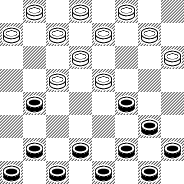
BLACK
Black to Move
There was dead silence in the auditorium as the students awaited Marvin's next moves.
"Here's where Black can take what amounts to a four-for-four shot," said Marvin, and made the following moves:
5. 7-10 19x12 6. 3-7 12x3 7. 14-17 21x14 8. 10x17 3x10 9. 6x29
Now the board looked like this:

WHITE
White to Move - and Win?
"So what do you think?" Marvin asked, flashing his trademark Belcher's Best Lite Lager grin.
Slowly the audience began to react. There were the sounds of seats shifting and feat scuffling. Finally, one student stood up, raised his arm and said, "Geez Marvin nobody'd ever play that one! Wassamattawhitcha anyhoo, showin' us dumb stuff like that! You been drinkin' too much a that beer a yours!"
This time, Marvin definitely turned red. "Well," he said. "Well, well, well."
Another kid piped up, "Hey that's a deep one Marvin, ha ha ha!"
Marvin paused at length, and finally seemed to become a bit more composed. He continued, "This is in fact thought to be a win for White, which is why this shot is seldom seen." Marvin grinned. Was that an evil grin on Marvin's face? "Perhaps, young man," he said in an even tone, "you would like to take the Whites, while I play the Blacks, and you can show me just how smart you really are by demonstrating the win."
There were hoots from the crowd, followed by cheers and applause, and cries of, "C'mon Billie, take 'em on! Show 'em yer stuff!" Then amidst nearly thunderous noise and commotion, the heckler stood up, ruffled his hair, tugged on his shirt and jeans, and started toward the front of the auditorium.
"Go Billie! Go Billie! Go Billie go!" the crowd chanted, over and over, louder and louder, until Billie arrived at the demonstration board on the stage. He grinned a little, looked back at the audience, then turned to the board and played......
Well, dear reader, just what did Billie play? Was the sassy fourth grader able to win this position against a top pro such as Marvin J. Mavin? Can you win this position?
To be continued.....
A Switcher Autopsy
The Checker Maven is delighted to present an article contributed by Richard L. Fortman with new analysis on the Switcher opening. It's a Checker Maven first and an exclusive! Our sincere thanks go to Mr. Fortman for this fine contribution, and to Brian Hinkle for both expert assistance and editorial preparation. Please send Mr. Fortman your comments on this new analysis: rlf111 at webtv.net. And, if you have analysis of your own that you'd like to see published, please write to the webmaster.
A Switcher Autopsy
Featuring new defenses from KingsRow and Chinook!
Notes by Richard L. Fortman, February 24, 2005.
Editorial assistance and additional computer analysis by Brian Hinkle using KingsRow.
1. 11-15 21-17 A
2. 9-13 B 25-21 C
3. 8-11 D 17-14 E
4. 10x17 21x14
5. 6-10 F 22-17 G
6. 13x22 26x17
7. 15-18 H 24-20 I
8. 2-6 J 29-25 K
9. 18-22 L 25x18
10. 10-15 28-24 M
11. 15x22 32-28 N
12. 6-10 O 23-18 P
13. 22-25 30x21
14. 10-15 27-23
15. 15x22 14-10
16. 7x14 17x10
17. 22-25 23-19
18. 11-15 20-16
19. 25-29 16-11
20. 29-25 11-7
21. 25-22 7-2
22. 5-9 Q 10-6 ? R
23. 1x10 2-7
24. 9-14 7-11
25. 14-18 31-27 S
26. 4-8 T 11x4
27. 22-26
Tinsley defeated Lowder, Game 4, 1975 Florida Open.
A - History tells us that James Wyllie used this weak reply in many of his GAYP exhibitions in order to "switch" or defer his opponents from their favorite Old 14th or Single Corner lines.
B - Applying the cramp which forms the opening. Other replies in 9-14 or 8-11 are seen in the 3-move openings.
C - To fill in the hole, to prepare for the exchange- other ways in 24-20 (Scott's Snake) or 23-18 are inferior, although Asa Long once tried the latter in the 1927 2nd international match vs. Harry Moulding, the English 'weak link.' Asa once told me, "I had won the first game with black and since this was close to the finish, with our team far ahead, I decided to go for the win with the weak side, much to the dissatisfaction of team captain Gus Heffner. Upon reflections it was a mistake, as I had to struggle to draw. (Black might have scored with Rubin's "Whipper-Snapper" gambit. --RLF)
D - Standard, as 5-9 instead is more often seen from the 9-13, 21-17, 5-9 opening.
E - Of the three major defenses, this was the original, as favored in the Willie Era - both Heffner and Bradford favored the 24-19 exchange, as witnessed in the 2nd I.M. whereas the third, the Andrew Jackson 30-25 remained in obscurity until adopted by Rubin in the 1929 7th American tournament (Cedar Point) or the 4-8 Switcher played in the 2nd I.M. The trunk reply was the overwhelming favorite; adopted 37 times followed with 24-19 5 times: then 23-18 and 24-20 - with 30-25 a notable absentee! - the last named was a lifetime favorite with Marion Tinsley. He told me he once asked his close friend Walter Hellman why he had stayed with the less restrictive 17-14x and Walter replied, "Well, Marion, they can only play one move at a time against it, and I know them all!"
F - Following up with the bind originated at note B; 4-8 instead allows a 'doctor' idea with 29-25, 6-10 and 23-19 etc. shown to draw.
G - Necessary. White cannot delay with 29-25, 10-17 and 25-21 as 4-8* 21-14 then 15-18x* etc. to a p.p. black win.
H - Marion Tinsley had long favored the 4-8 and 1-6 attack throughout his long career but when faced with a 'do or die' decision, playing Elbert Lowder in the final 4th game of the final round in the 1975 Florida Open ty. he "switched' to the text. In discussing this game on a later visit to Springfield, Ill., he said, "As you know, I had to win this game, as a draw would win this tournament for Lowder on honor points so I decided this "surprise" element might confuse him; however, as play progressed, I began to think it might have been a mistake as he kept on making the necessary moves - as it turned out. Only a little 'swindle' saved me."
I - Checker theory recommends advancing toward the center and avoid side moves such as this, but there are exceptions to every "rule" that have been proposed - here 24-19? 4-8 29-25 11-15 28-24 8-11 17-13 10-17 23-14 then either 15-18 or 17-22 rupture the white formation - and if 29-25 instead, black has Wyllie's 18-22 pitch to penalize the defense by his long time opponent Robert Martins. However, KingsRow prefers 7. ...23-19
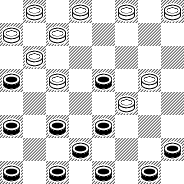
BLACK
Black to Play
J - Holding the bridge, instead of the other formidable attack in 1-6, followed with 3-8, leading into the classic win by 18 year old Asa Long over his more experienced opponent, English champion Alfred Jordon in the semi-finals of the 1922 5th Amer. Ty. at Boston, Asa then going on to win his first American tournament by defeating Jordon again in the final round. While visiting me in 1985, Asa commented, "Perhaps, my most satisfactory win, as I had little respect for Jordon as a sportsman, forcing me to play out endings as if I was a beginner."
K - Here the early 28-24 loses after 6-9*, as shown in Master Play (see Marion Tinsley's remarks in note H). However, there is a new sound defense confirmed to draw by Chinook with 17-13x! No analysis was sent in from Jonathan Schaeffer so KingsRow provided this line: 8. ...17-13 9. 10x17 23x14
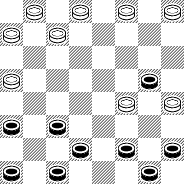
BLACK
Black to Play
L - Black is now confined to this one powerful reply.
M - Also, 27-24, 15-22 and the key 32-27 is the same, as played in an obscure game, J. Steele vs. Harry Pillsbury - the last named was rated as the strongest 'mixed' player of the 'sister games' - chess and checkers, along with Newell Banks.
N - A valuable "waiting" move, again avoiding the 24-19 advance shown to lose. As Tinsley once observed, " Knowledge is power!"
O - The position reached by Tinsley vs. Lowder, mentioned in note H. I was not present, but Howard Owen wrote me later that the majority of players had completed their round but stayed over to watch the finish - he said, " The tension was high, and you you could almost hear a pin drop! Was the world champion on the verge of losing his first tournament since Paxton in 1950?"
P - The first small chink in white's armor, giving the champion a faint ray of hope - here, Wyllie's 24-19 (avoided earlier) is now best, as played vs. Robert Martins - in a later letter, Tinsley told me he had been over this 23-18 in his early career, when stationed at the Great Lakes Naval Center in Chicago (1946) and studying at the Rex Wood Library in Gary, Ind. He said he had found a little 'kink' (as he put it) that varied from the Master Play variation, and later tried vs. his playing partner Roy Hunt. - Instead of either 24-19 or 23-18, Ed Gilbert's KingsRow checker software came up with a new defense in 23-19! that has remained hidden for the past century and a half! ... 12. ... 23-19
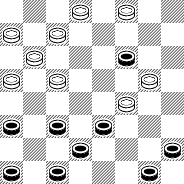
BLACK
Black to Play
Q - The play from note P is virtually forced - the text is the Tinsley 'kink' (or cook) as mentioned in note P which varies from the Master Play 22-18, which also requires care to draw after 31-27* (not 21-17, 18-22 to a black win) then 4-8 and the 10-6 exchange to draw.
R - With the clock running, the position is murky. It is obvious that white must pitch to escape the bridge, and on the surface it might appear that either way would draw - but not so! This loses, whereas, 10-7* escapes after 3-10, as played by Hunt, although he didn't send their conclusion. I looked at 2-7* (as 2-6 lets in 4-8, 6-13 and 8-11) 9-14, 7-11, 22-18, 11-7, 18-23, 24-20 etc. to draw.
S - The king move with 11-7 allows18-23, 7-14 22-18 19-10 and 18-9 strands the piece, black wins.
T - A neat conclusion to a hard fought game.
The Checker Maven is produced at editorial offices in Honolulu, Hawai`i, as a completely non-commercial public service from which no income is obtained or sought. Original material is Copyright © 2004-2026 Avi Gobbler Publishing. Other material is public domain, AI generated, as attributed, or licensed under CC1, CC2, CC3 or CC4. Information presented on this site is offered as-is, at no cost, and bears no express or implied warranty as to accuracy or usability. You agree that you use such information entirely at your own risk. No liabilities of any kind under any legal theory whatsoever are accepted. The Checker Maven is dedicated to the memory of Mr. Bob Newell, Sr.
